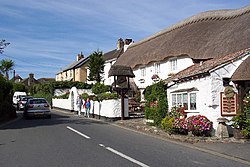Croyde
| Croyde | |
| Devon | |
|---|---|
 Croyde | |
| Location | |
| Grid reference: | SS4439 |
| Location: | 51°7’59"N, 4°13’1"W |
| Data | |
| Post town: | Braunton |
| Postcode: | EX33 |
| Dialling code: | 01271 |
| Local Government | |
| Council: | North Devon |
| Parliamentary constituency: |
North Devon |
Croyde is a pretty seaside village on the rugged north coast of Devon, with a west-facing beach looking at the Atlantic Ocean.
The village is on the course of the South West Coast Path and nearby is Baggy Point, which is owned by the National Trust. The village is wholly within the 'North Devon Coast Area of Outstanding Natural Beauty'.
Croyde village and its beach faces the Atlantic Ocean near the western limit of the Bristol Channel.
A little brook, Croyde Stream, runs through the village and onto the beach. The centre of the village is roughly at the intersection of Hobbes' Hill, Jones' Hill and St Mary's Road. At this spot, Croyde Bridge carries the road over the stream.
Today
The village has several small campsites, a small retail area and two large holiday parks; Croyde Bay Holiday Resort (operated by UNISON) and Ruda Holiday Park, operated by Parkdean Holidays.
The past 30 years has seen large increases in younger-age visitors develop around surfing. The impact of tourism on the village has been varied. Some local landowners have benefited from the increased property prices. Tourism has helped to create jobs that were lost in agriculture. Local farming has declined, with former farmland converted into caravan sites and fields for seasonal camping. Like many seaside villages, the phenomenon of second homes has pushed house prices beyond the reach of most local people. There is little year-round employment, because tourism is seasonal, and most businesses are closed out of season.
Since 1999 Croyde has hosted an annual surfing and music festival (GoldCoast Oceanfest) on the weekend closest to midsummer.
During the summer season there is an outdoor market each Tuesday which is held in a field off Moor Lane past Ruda Holiday Park heading towards Baggy Point.
Beach

A large dune system has formed past the high-tide mark. Sand underlies the land surface between the beach and the centre of Croyde village, 600 yards to the east. The beach forms the middle section of a trio of sandy beaches north of the Taw Estuary. The Saunton Sands, 3¾ miles long, ⅔ miles to the south, while Woolacombe Sands, almost two miles long, are a mile to the north.
Surfing
Croyde is used for surfing; the rides are generally short as the waves tend to pitch up and break]] quickly. There is a point break off Down End and a reef break at the northern (Baggy Point) end of the beach that works for about 60 minutes during some high tides. The shape of the bay funnels waves towards the beach.
The break is very compact at low tide, resulting in many injuries.
The beach is steeper than either Woolacombe, Putsborough or Saunton Sands. Due to this, rip currents are extremely strong especially near the rocks at either end of the beach and at low tide, even when there is only a small swell. These currents present danger to the strongest of swimmers.
Outside links
| ("Wikimedia Commons" has material about Croyde) |